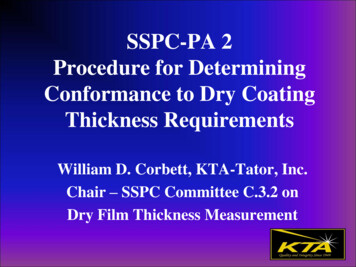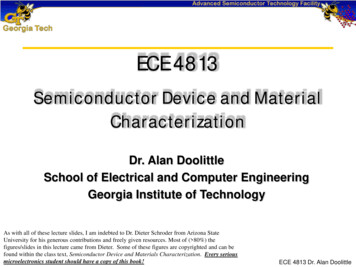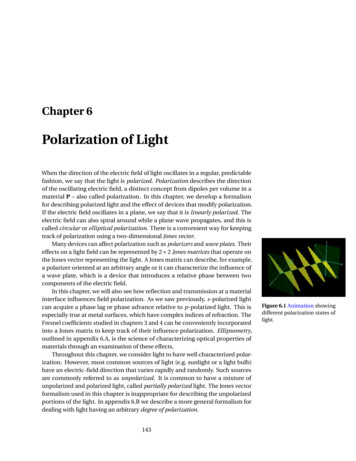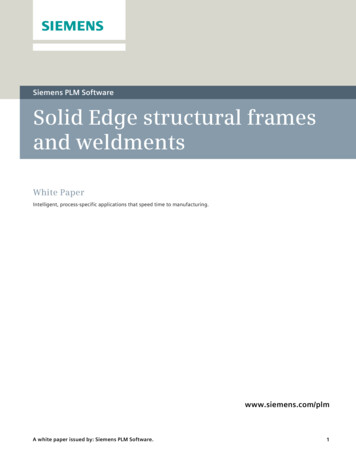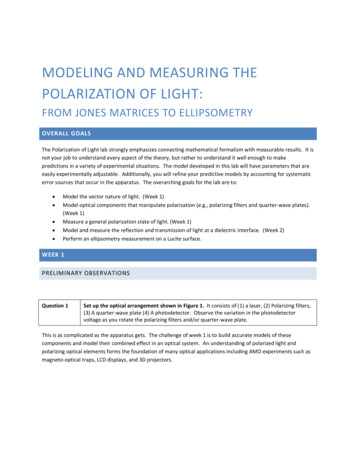
Transcription
MODELING AND MEASURING THEPOLARIZATION OF LIGHT:FROM JONES MATRICES TO ELLIPSOMETRYOVERALL GOALSThe Polarization of Light lab strongly emphasizes connecting mathematical formalism with measurable results. It isnot your job to understand every aspect of the theory, but rather to understand it well enough to makepredictions in a variety of experimental situations. The model developed in this lab will have parameters that areeasily experimentally adjustable. Additionally, you will refine your predictive models by accounting for systematicerror sources that occur in the apparatus. The overarching goals for the lab are to: Model the vector nature of light. (Week 1)Model optical components that manipulate polarization (e.g., polarizing filters and quarter-wave plates).(Week 1)Measure a general polarization state of light. (Week 1)Model and measure the reflection and transmission of light at a dielectric interface. (Week 2)Perform an ellipsometry measurement on a Lucite surface.WEEK 1PRELIMINARY OBSERVATIONSQuestion 1Set up the optical arrangement shown in Figure 1. It consists of (1) a laser, (2) Polarizing filters,(3) A quarter-wave plate (4) A photodetector. Observe the variation in the photodetectorvoltage as you rotate the polarizing filters and/or quarter-wave plate.This is as complicated as the apparatus gets. The challenge of week 1 is to build accurate models of thesecomponents and model their combined effect in an optical system. An understanding of polarized light andpolarizing optical elements forms the foundation of many optical applications including AMO experiments such asmagneto-optical traps, LCD displays, and 3D projectors.
Figure 1: Diagram of a scheme for the measurement of elliptical polarization parameters and the creation of circularly polarized light.INTRODUCTIONLight is a propagating oscillation of the electromagnetic field. The general principles that govern electromagneticwaves are Maxwell's equations. From these general relations, a vector wave equation can be derived.⃗⃗(1)One of the simplest solutions is that of a plane wave propagating in the ̂ direction is⃗()̂()̂()(2)Whereandare the electric field magnitudes of the -polarization and -polarization,is the angular is the wave-number, andfrequency of the oscillating light wave,andare phase shifts.Question 2Use complex exponential notation to express the plane wave shown in Eq. 2. The real part of thiscomplex expression should match Eq. 2.Most of our other optics labs assume that light is a scalar field, and obeys a scalar wave equation,,but the whole point of this lab is to model and measure the vector nature of light.Question 3Reflect. What experiments and other optics phenomena have you studied in the lab? Did theseuse a scalar model of light or a vector model?EXPERIMENT: DETERMINING POLARIZATION OF YOUR LASEROne of the most basic polarization optics is the polarizing filter. An ideal polarizing filter absorbs 100% of onepolarization and transmits 100% of an orthogonal polarization. For now we will assume the polarizing filters youhave in lab are ideal. Later in the lab we will experimentally develop a model for non-ideal filters which are closerto what we have in lab.
Question 4Given three things: (1) a laser, (2) a polarizing filter, and (3) and a photodiode:a.b.Design and carry out a quick experiment to determine if the light emitted by your laserhas a well-defined polarization.Design and carry out a quick experiment to determine if your photodiode respondsequally well to all polarizations of light.MODELING THE POLARIZATION OF LIGHT WITH JONES VECTORSIf we look back at Eq. (2) we see that only free parameters describing the electric field of a plane wave are the twoelectric field amplitudesand , and the phasesand . In fact, based on your answer to Question 1, it ispossible to rewrite the complex exponential form for the electric field as⃗(Question 5())̂[̂](3)Show that Eq. (3) follows from your answer to Question 1.b. Find., andin terms ofandThe only thing that is different between different states of polarized light are the complex valued coefficients infront of ̂ and ̂. In the experiments we are doing this week, we are not concerned with the direction the light ispropagating, or the spatial shape of the beam, or the wavelength. If we strip away all the extraneous details ofEqs. (2) and (3), we can write the polarization state of light as a 2x1 vector.()̂[̂]()(4)So, for example, for light polarized purely in ̂ or ̂ we get̂( )̂( )(5)These are the two basis polarization states in the Jones matrix notation. Throughout this lab you will bedeveloping the mathematical and computational representations for a model of polarized light based on the Jones1Formalism.Question 6Suppose two beams of light of different polarization () and () are being combined usinga beam splitter. The Jones matrix formalism suggests that the final polarization state after a50/50 beamsplitter would be proportional to (). Under what experimental conditionswould this use of the Jones formalism be valid, meaning it would accurately describe the finalpolarization state of the light?Question 7Write a Jones vector in the form of Eq. (4) for linearly polarized light with a polarization angle 45degrees between ̂ and ̂.
CONSTRUCTING AND REFINING A MODEL OF A POLARIZING FILTER USING THE JONESFORMALISMThe next few questions will lead us through describing optical components that take a polarization state and turn itinto a different polarization state. All of these components can be described by 2x2 matrices.An ideal polarizer oriented along the -axis keeps the ̂-component unchanged, while the ̂-component vanishesbecause it is not transmitted. Or in the formalism of Jones(Question 8Question 9)()(6)Do a little research in order to explain the basic physics ideas for why the polarizing filter onlyabsorbs one polarization.a.Find the coefficients , , , and of a 2x2 matrix which describes the behavior of anideal polarizing filter which transmits only the ̂-polarization as given in Eq. (6), so that(b.)()().What is the physical meaning of the diagonal elementsmeaning of the off-diagonal elements and ?and ? What is the physicalOur actual polarizer is probably not ideal. It does transmit 100% of any polarization, and probably lets a little bit ofthe orthogonal polarization through.Question 10Experiment: Refining the idealized model of a polarizing filter to be more realistic.The ideal polarizing filter transmits 100% of one polarization and 0% of the orthogonalpolarization. Is this a good model of the real polarizing sheets we are using in the lab?a. Design and carry out an experiment to measure the maximum and minimumtransmission coefficients and construct a more realistic model of the polarizer.b. Write a matrix for a more realistic model of the non-ideal polarizing filter measured in(a).c. Do the polarizing filter characteristics depend on where on the sheet the laser strikesthe polarizer?Hint: The power in a optical beamis proportional to the square of the electric fieldmagnitude, ⃗ () .MALUS'S LAW – AN EXPERIMENTAL TEST OF OUR MODEL OF LIGHT AND POLARIZINGFILTERS.Malus's law says the fraction of linearly polarized light transmitted through an ideal polarizer iswhere is the angle between the incident polarization and the transmitting axis of the polarizer.Question 11Briefly explain the basic physics of Malus's law. It is fine to consult a textbook.,
If our model of the polarization of light and model of the polarizing filter are a good description, then we should beable to use this model to derive Malus's law in the case of non-ideal polarizing filters. This section will lead youthrough this modeling exercise.Briefly, a rotation matrix by an angle theta can be written as( )()(7)This matrix can be used to rotate a polarization state, or to rotate an optical element. It will probably be helpful towrite express these matrices as functions in Mathematica, which would look liker[th ]: {{Cos[th], Sin[th]}, {-Sin[th],Cos[th]}}A polarizing filter matrix which transmits ̂,given bythat is rotated by an angle , the rotated polarizer has a matrix( )( )()(8)2If you want more details on defining functions in Mathematica , there is a YouTube screencast and a Wolfram3tutorial available. Mathematica also has many capabilities for handling vectors and matrices, which are4documented in the built-in help or on the Wolfram website. In particular, a vector can be represented as a {a1,a2}, a matrix can be represented by b {{b11, b12}, {b21, b22}}. Also, the “dot” operator (aperiod) is used for multiplication between matrices and other matrices, like b.b, and matrices and vectors, likeb.a.Question 12Using the Jones formalism to predict Malus’ law will give you confidence in more complicatedmodels, like those that include the quarter-wave plate.a.b.Question 13Express in Mathematica the matrix ( ) for a polarizing filter at an angle . Does() agree with what you expect?Use the Jones formalism computational model to predict the transmission between twosuccessive polarizing filters oriented at angles differing by . Does it agree with Malus’Law, i.e.?Experimentally test your model of Malus's law using non-ideal polarizers. Do you getagreement within measurement uncertainties?MODELING A QUARTER-WAVE PLATE WITH JONES MATRICESA quarter-wave plate is an optic that transmits both orthogonal polarizations, but the index of refraction isdifferent for the two polarizations. So although they traverse the same physical length, one polarization travelsmore slowly than the other, and exits the quarter-wave plate with a slightly different phase. Mathematically, wecan write a matrixdescribing the ideal QWP as()(9)
It is almost the same as the identity matrix, but for a quarter-wave plate the ̂-polarization exits with an additionalphase shift relative to the ̂-polarization. One common application is for creating circularly polarized light.Question 14The quarter-wave plate is made of a crystal, commonly quartz.a. What is the difference between the molecular structure of glass and a quartz crystal?b. Could a glass plate act as a quarter-wave plate? Why or why not?Question 15Represent the quarter-wave plate matrix in Mathematica. Use the representation to predict theoutgoing state of light when the input polarization has an anglea. 0 degrees to the ̂-axis.b. 30 degrees to the ̂-axis.c. 90 degrees to the ̂-axis.CREATING, MODELING, AND MEASURING ELLIPTICALLY POLARIZED LIGHTA general state of polarized light is often called elliptically polarized light because the polarization vector has amagnitude and direction that follows an elliptical pattern over time. Two demonstrations on the Wolfram56demonstrations website might help you visualize what is going on. We can write this arbitrary polarization statein the following way:()It turns out that only the difference between the two phases,(10), is responsible for the ellipticalpolarization state, so in this lab we will represent an arbitrary elliptical state as(Question 16)(11)When measuring light with a photodetector, explain why we can’t distinguish between thestates in Eq. 10 andin Eq. 11?WEEK 1 GRAND CHALLENGE1.2.3.4.Design a scheme to measure the parameters of elliptically polarized light: , , andAttempt to create circularly polarized light.Model systematic error sources and determine which ones are limiting your ability to produce circularlypolarized light.Modify your experiment to create more pure circularly polarized light.The following set of questions should lead you through this process. Half of your formal written or oralpresentation will be explaining this experiment and your results.
Question 17A measurement of the parameters of elliptical polarization, and, using arotatable polarizing filter.a. Predict the power transmitted through the polarizing filter as a function of thepolarizing filter’s orientation,for an arbitrary polarization state in Eq. 11.Mathematica’s Manipulate7 function may be helpful for seeing how the predictionchanges as you vary and .b. Use the predictive function as a fit function for real data. A test data set is available on8the website. The polarization parameters used to generate the test data were, and. Note that your fit may look good, but return differentparameters. This could be for a few reasons: Changing by only adds a minus sign to the electric field, which doesn’tchange intensity measurements. Changing or bychanges gives the exact same field, so adding multiplesofdoesn’t change the measurement. Changingis okay if we also change(this also just changesthe electric field by a minus sign) Changingalso gives the same prediction, which is highly significantbecause it means this simple measurement cannot distinguish between leftand right-handed circular polarizations.Question 18Production of circularly polarized light using polarizing filters and quarter-wave plates.Figure 1 shows a setup which uses a quarter-wave plate to manipulate the polarization state oflight. For two different angles of incident polarization (45 degrees and another of your choosing):a. Predict the elliptical polarization parameters after the quarter-wave plateb. Predict the power transmitted through the analyzing polarizer as a function of its angle.c. Take data for this situation, and use the model to fit for the parameters and .Note: Make sure you consider how you are calibrating the zero of the angles, such as the incidentpolarization, the quarter-wave plate, and the analyzing polarizer.
Question 19This question explores the systematic error effects that could limit your ability to producecircularly polarized light.In an ideal setup, when you aligned the input polarization at 45 degrees from the quarter-waveplate’s axis, you would have created perfectly polarized light, and the power measured by thephotodetector should not depend on the analyzing polarizer’s angle. But you probably didn’tget perfectly polarized light.Among the possible idealizations to consider, three can be relaxed and accounted for using yourmodel of polarized light. These idealizations are:1.The light incident upon the quarter-wave plate is perfectly linearly polarized ().The light incident upon the quarter-wave plate is exactly 45 degrees from the axis of thequarter-wave plate.The quarter-wave plate adds exactly a phase shift between the fast and slowpolarizations.2.3.Your computation model can predict the result of your measurement in the previous questionwhen these idealizations are violated. For these three idealizations determine the following:a.b.c.d.e.Question 20Predict how a small violation of the idealization would change the result.Can you distinguish between the three systematic error sources?Could this systematic error source account for non-ideal result?Is the violation of the idealization within tolerances on our ability to measure angles, orthe specifications on the quarter-wave plate?Which error source, if any, is most likely?Can you use your understanding of the systematic error sources to modify your setup to improvethe circularity of the light? How and why would you make changes?WEEK 2A BASIC MODEL FOR REFLECTION AT A DIELECTRIC INTERFACEIn week 1 we developed a model for describing light that contained information about the polarization, but had noinformation about the direction of propagation, wavelength, beam profile, etc. In week 2 we are going to studythe reflection and transmission of polarization waves at an interface between two dielectrics.The general principles needed to model the wave propagation and reflection are⃗⃗⃗1.Maxwell's wave equation given in Eq. (1):2.Boundary conditions which need to be satisfied between to media⃗⃗a.b.⃗⃗c.⃗⃗⃗⃗d.⃗⃗ The component of the electric field parallel (tangential) to the surface is continuous.The component of the magnetic field normal to surface is continuous.⃗⃗
In addition to the general principles we need to specify the specific situation where we will apply the generalprinciples listed above. The simplest and most idealized model makes the following assumptions:1.2.3.The interface between the two dielectrics is an infinite plane.The properties of the two dielectric materials are as follows:a. The dielectric permittivity in each material is uniform with values of for the incident wave, andin the medium where the transmitted wave propagates.b. The magnetic permeability in the two materials is no different from vacuum, so.The electromagnetic wave is an infinite plane wave with an wave vector ⃗ which specifies the wavelengthand direction of propagation.Using the general principles (the wave equation for ⃗ and boundary conditions) in the specific idealized situationabove, we can derive the following reflection and transmission coefficients for the two polarizations fieldamplitudes. (see Hecht Optics Sec. 4.6)For the polarization normal to the plane of incidence (also called s-polarization)(12)(13)For the polarization parallel to the plane of incidence (also called p-polarization)(14)(15)Where the transmitted angleis given by Snell's law(16)Question 21Pre-labMath-PhysicsDataConnectionDraw a diagram which explains the following quantities:a. Plane of incidenceb. Electric field polarization normal to the plane of incidencec. Electric field polarization parallel to the plane of incidenced.e.The power reflection and transmission coefficients can be derived by considering the power that flows in and outof an area on the surface of the interface. In vacuum, the intensity of light is related to the electric fieldamplitude by (17)
In a dielectric where the propagation speed iselectric field byand the dielectric constant is, the intensity relates to the (18)The reflected power coefficient is the ratio of reflected and incident powers incident upon an area A on thesurface of the interface. It can be related to the amplitude reflection coefficient by (19)where we made use of the fact that speed of propagation , the dielectric constant , and the angles of theincident and reflected beams, and , are equal.Similarly, the transmitted power coefficient is the ratio of transmitted and incident powers incident upon an areaA on the surface of the interface. It can be related to the amplitude transmission coefficient by (20) where we made use of the relation, the relationfor typical dielectrics, and relates the velocity of propagation ratio to the index of refraction ratio. Question 22Pre-labMath-PhysicsDataConnectionPrediction of reflection and transmission coefficients (a.k.a “Fresnel equations”).a. Create a computational representation of this model of reflection and transmission at adielectric interface. In particular, code up functions for the four amplitude coefficients:, , , and , and the four power coefficients: , , , and .b. Use the functions in part (a) to make plots of four amplitude coefficients as a function ofthe incident angle .c. Use the functions in part (a) to make plots of the four power coefficients as a function ofthe incident angleQuestion 23Take reflection and transmission coefficient dataa. Design a procedure and apparatus to measure the transmission and reflectioncoefficients, , , , and , as a function of the incident angle. Make sure yourprocedure includes both cases of measuring both air to Lucite, and Lucite to airreflection/transmission. Figure 2 may help you get started.b. Draw a diagram showing the alignment of the Lucite, rotation state, and incident,reflected, and transmitted laser beams.c. In order to measure the four coefficients, you need to create incident light that ispolarized parallel or perpendicular to the plane of incidence. At the Brewster angle, ,when, and the reflected light is pure s-polarized(perpendicular to plane of incidence). Use this information to calibrate the alignment of the initial polarizer.d. Carry your procedure and quantitatively compare your results with the predictions youmade in the pre-lab question. Which data sets had the best agreement? Which had the worst?
Figure 2: One option for the apparatus used in testing the Fresnel equations.LIMITATIONS AND REFINEMENT OF THE FRESNEL REFLECTION MODELIn the model of reflection of light from a dielectric interface developed in this lab, many idealizations are made.These include:1.2.3.4.The incident wave is a plane wave.The medium is uniform.The interface is an infinite plane.The reflection and transmission coefficients only describe the electric fields very close to the interface.The first assumption, that the incident wave is a plane wave, is only approximately true. We know the laser is wellapproximated by a Gaussian beam which is composed of a spread of wave-vectors ⃗ . Although there aremeasurable differences between a plane wave and a Gaussian beam and a plane wave, we are not going to explorethis further because it doesn't involve polarization.The fourth assumption is that the measurement of transmitted and reflected power are only made right at thedielectric interface, but clearly our photodiode is positioned away from the interface.Hopefully, the next two questions demonstrate that it is important to be explicit about the assumptions in ourpredictive models, because it gives us hints as to where our experimental results might deviate from ourpredictions, and how we can refine the models to improve the agreements between prediction and experiement.
Question 24Absorption and scattering in the Lucitea. What effect would absorption and or scattering have in your measurements of thetransmission and reflection coefficients? Which of the eight predictions would change?b. What effect would the reflection at the curved dielectric interface have on yourmeasurements? Which of the eight predictions would change?c. How could these deviations be included in the predictions as a fit parameter? Shouldabsorption, scattering, or the second reflection cause an effect which depends on angle?d. Re-plot your data and prediction using the revised model. Do you get betteragreement?Question 25Birefringence in Lucite:Quick test of the transmitted beam:Stress in plastics like Lucite cause birefringence, which is the same property of quartz thatallows us to engineer quarter-wave plates. However, the birefringence in Lucite is not easyto control, and will vary from sample to sample, and may cause large changes in thetransmitted polarization.a.Using simple physics reasoning, for a uniform dielectric medium, how should theincident and transmitted polarization states relate to each other at normal incidence,b.Experimentally compare the polarization state of the incident and transmitted beam.How much did it change?In Question 19 you measured 8 sets of data for the Air-to-Lucite or Lucite-to-Airreflection and transmission coefficients ( , , , and ). Knowing that birefringencein the Lucite can change the polarization state of the transmitted beam, which of thoseeight measurements may not be reliable? Why?c.GRAND CHALLENGE: ELLIPSOMETRY OF LUCITEEllipsometry is a technique used to characterize the thickness and index of refraction of thin films. It is widely usedin industrial and academic research. The technique also involves almost everything you have learned from the labso far, in particular your ability to measure the parameters of an arbitrary polarization state, and the experimentalsetup for measuring reflection coefficients vs angle.Figure 3: Basic ellipsometry Setup. Modified from http://en.wikipedia.org/wiki/File:Ellipsometry setup.svg
A standard ellipsometry setup is shown in Figure 3. The standard measurement in ellipsometry is to measure themagnitude and phase of the ratio of the parallel and perpendicular polarization reflection coefficients, i.e.,( )(21)Question 26Reflect: You already took measured reflection coefficients vs. angle of incidence for the airLucite interface. Is this data sufficient to determine and ? Why or why not?Question 27For the air-Lucite reflection studied in the previous section, use your Fresnel model to predictand as a function of the angle of incidence .The full ellipsometry measurement uses the Jones formalism derived earlier, in particular the measurement of anarbitrary elliptical polarization state. However, instead of choosing ̂ and ̂ as two orthogonal directions forpolarization we can use the orthogonal and parallel polarizations to the plane of incidence. The unit vectors forthese two polarizations can be represented as vectors:Question 28a.b.( )(22)̂( )(23)If the incident light is polarized 45 degrees from the parallel polarization, what is theJones vector for the reflected light of the light in terms of and ?Using your method from week 1 of determining arbitrary polarizations, you canmeasure the parameters, , and for the arbitrary elliptical state of thereflected light that was polarized at 45 degrees from parallel polarization(). Find a mathematical relationship between the elliptical polarizationcoefficients andEquation 20.Question 29̂and the standard ellipsometry coefficientsanddefined inMeasure and as a function of the angle of incidence and compare with your predictions.The standard procedure for ellipsometry data is to determine the index of refraction (andthickness, typically) of the sample by finding the set of model parameters that best matches thedata. Carry out this analysis for your Lucite data.If you complete the ellipsometry of Lucite, then congratulations are in order! You have accomplished manyscientific tasks, such as developing accurate predictive models, calibrating measurement devices, assembling anapparatus, and carrying out sophisticated data analysis. A natural next step would be measuring thin film layers,which employs similar experimental techniques, but requires more complicated models of reflection from themultilayered surface.
PROJECT IDEAS1.2.3.4.5.Build an ellipsometer. First, use it to measure the index of refraction of a substrate. Then use it tomeasure the thickness and index of refraction of a thin film. What is the thinnest film you could measurewith this method? Can you measure films thinner than the wavelength of light? What are theperformance specifications for measuring and ?Extending the Jones Calculus to include unpolarized light. One of the primary limitations of the Jonesrepresentation of polarization is that it is only valid for a general state of polarized light, but cannotdescribe unpolarized, or partially polarized light. This project would extend the model to include partiallypolarized light, and to create ways to measure the polarization state. It could also explore the connectionbetween describing the polarization of light and the quantum mechanical formalism of a spin ½ system.Developing a physical model of unpolarized light This project focuses on modeling unpolarized light asan electromagnetic wave with a randomly fluctuating polarization direction. This project will go in depthinto modeling and measuring statistical properties of light. Possible directions include measuring both thecoherence time of a single polarization, and the cross-correlation time between two orthogonalpolarization states of an unpolarized laser. This can be done without fast electronics, but requires anunderstanding of interference. Using information learned from these measurements, design ameasurement to directly measure polarization fluctuations of the laser. Especially consider the relevantperformance specifications of the detectors and electronics.Polarization behavior of liquid crystals. Experimentally demonstrate that a liquid crystal can act as avariable retardance wave plate which is controllable by the applied voltage. Use the liquid crystal tophase modulate and amplitude modulate your light, and create a detection scheme for phase andamplitude modulated light. Experimentally test the performance specs of your modulator/demodulator.Encode and decode a fun message or music as a proof of principle demonstration.What happens to the transmitted beam when the angle is past the critical angle and the reflection goesto 100%? There is still an electric field where the transmitted beam would be, but it has an exponentiallydecaying amplitude. Model this exponentially decaying field, called an evanescent wave. Model thecoupling of the evanescent wave to some other optical device, like another chunk of glass, or an opticalfiber. Measure the coupling of the evanescent field to this optical device as a function of angle ofincidence and separation distance of the device from the interface of reflection. Demonstratequantitative agreement between your model and measurements.REFERENCES1Jones, R. C. “A New Calculus for the Treatment of Optical Systems.” Journal of the Optical Society of America,31(7), 488-493. doi:dx.doi.org/10.1364/JOSA.31.000488 s3340/phys3340 sp12/sample data/Test Polarization Data.csv
So, for example, for light polarized purely in ̂ or ̂ we get ̂ ̂ (5) These are the two basis polarization states in the Jones matrix notation. Throughout this lab you will be developing the mathematical and computational representations for a model of polarized





